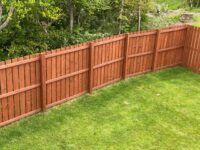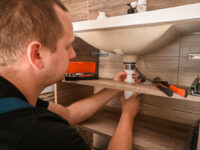The Basics of Water Damage Restoration
Water damage restoration is a comprehensive, professional process that returns damaged areas to their pre-loss condition. It includes inspecting and labeling shut-off valves, removing water and wet materials, drying structures with specialized equipment, and cleaning and sanitizing the affected areas.
Sentimental items, such as childhood memorabilia and family heirlooms, are especially vulnerable to irreparable damage from water. Important documents can also be rendered illegible, creating serious problems with identity and legal matters. Visit their Website to learn more.
1. Assess the Damage
 The first step is to assess the situation and determine how much water damage has occurred. If you’re unsure of the extent of the damage, call in a professional to do an inspection and create a restoration plan. The professionals can also determine what caused the water damage, which will help them better understand how to restore your property.
The first step is to assess the situation and determine how much water damage has occurred. If you’re unsure of the extent of the damage, call in a professional to do an inspection and create a restoration plan. The professionals can also determine what caused the water damage, which will help them better understand how to restore your property.
Once the experts inspect the area, they’ll start the process of removing the water. This involves locating the source and turning off any electrical equipment near the water to avoid potential hazards. Then, they’ll use industrial-grade pumps and vacuums to remove as much water as possible. The faster this is done, the less damage your property will experience.
This is followed by drying the area with specialized equipment like dehumidifiers and air movers. This not only prevents further damage to your property but can also prevent mold growth and other health issues.
The experts will also classify the type of water damage, which helps them determine safety measures and other important factors. This can be helpful for homeowners insurance claims, as it allows them to know what steps need to be taken based on the category and severity of the water damage.
Lastly, the experts will clean and sanitize the area to remove any bacteria or other contaminants. This includes everything from carpeting and upholstery to studs and joists. This is followed by structural repairs to bring your home back to its original condition.
2. Remove the Water
The first step in water damage restoration is to remove any standing water from the affected area. This may involve the use of specialized equipment, such as wet vacs or pumps. This step is crucial, as it prevents further damage to the affected materials and reduces the likelihood of mold growth.
After removing the water, the professionals will begin to dry out the space. This is a complex process that involves using specialized drying equipment, cleaning and sanitizing the area, and sometimes making structural repairs. The longer the water sits in a room, the more damage it can cause to wooden materials and metal items. It can also lead to rust and corrosion.
In addition to causing structural damage, water can also create health hazards. Standing water provides an ideal breeding ground for bacteria and fungus, which can cause diseases and illness in humans and pets. Additionally, if the water is contaminated with sewage or black water, it can pose serious health risks to home occupants.
The best time to begin water damage restoration is within the first 24-48 hours after a loss occurs. This allows professionals to extract more water and dry the affected areas quickly, minimizing long-term issues. It also gives them the best chance of preventing mold growth and other problems. During this time, it is important to turn off electricity to avoid any potential shocks and ensure the safety of occupants.
3. Dry the Area
If the water damage is severe, you may need to use specialized equipment to dry out the area. This includes dehumidifiers and fans that circulate air to remove moisture. This is a crucial step in the restoration process, as it can prevent further damage to materials and help restore the property to its normal condition.
It’s important to remember that the area needs to be completely dry before any repairs can begin. It’s also not a good idea to redecorate until the area is dry, as painting over wet walls or floors can lead to problems later on.
Identifying and fixing the source of the water is important, as it can stop more damage from occurring. If possible, removing items from the affected areas is also helpful to reduce overall damage. It’s also a good idea to use fans and dehumidifiers to get the moisture level down, as it will make cleaning and drying the area much easier.
Once the area is dried out, it can be cleaned and sanitized before any structural repairs are done. This will ensure that no mold spores or other contaminants are left behind, which can cause further damage to the property. This may include sanitizing and applying antimicrobial treatments, as well as cleaning or replacing carpeting and drywall. The last step in the restoration process is completing any necessary structural repairs to bring the property back to its original condition.
4. Clean the Area
Once the water has been removed and the area is dry, it’s important to clean and disinfect the area. This can help prevent mold and mildew growth, which can be harmful to your family’s health. Using a disinfectant cleaner and scrubbing surfaces will ensure that any bacteria and other contaminants are removed from the area.
Professional restoration technicians have the equipment and expertise needed to thoroughly clean and sanitize the area after a water disaster. They’ll use specialized pumps and vacuums to remove any remaining moisture from the area, preventing further damage to wet materials and eradicating sites for mold and bacteria growth. They’ll also use air scrubbing and high-efficiency particulate air (HEPA) cleaning techniques to eliminate dangerous pathogens from the space.
It’s important to act quickly when you notice water damage in your home. Mitigation efforts can minimize the impact of the issue by addressing the source of the problem and containing leaks. Water damage restoration is a more in-depth process that addresses the full extent of the damage. This can include everything from replacing drywall and flooring to repairing electrical systems and plumbing. By following these steps, you can restore your home to its original condition and protect your family from long-term damage. Professional restoration technicians can provide you with peace of mind and confidence that the job will be done right. They’ll make sure that every detail is addressed and that your home is safe and healthy for your family.
5. Sanitize the Area
Once the standing water is removed, it is time to clean and sanitize the affected area. This step is crucial because it helps to mitigate additional damage, prevent health hazards, and protect property. During this process, experts will use specialized cleaning agents and disinfecting techniques to remove lingering moisture and harmful bacteria from the space. This step also helps to eliminate unpleasant odors.
If left untreated, water damage can cause mold growth, which can lead to respiratory issues and other health problems. Additionally, it can deteriorate structures like wood and metal. That’s why it is important to act quickly and hire an experienced professional when dealing with water damage.
When hiring a water damage restoration company, make sure that they are certified and licensed by the state. This ensures that the company follows proper practices and adheres to industry standards. It is also a good idea to hire an IICRC-certified technician, as this shows that the technician has received extensive training and is knowledgeable about how to repair water damage. Additionally, an IICRC-certified technician will be able to work with your insurance company to ensure a smooth claim process. They will be able to provide you with accurate estimates and inform you of any potential problems that may arise during the restoration process.
6. Repair the Damage
Water damage restoration is a process that can help you restore your property after a flood, leak or burst pipe. It can prevent structural damage, preserve your belongings and save you money on repairs down the line. The key to restoring your home or business is quick action.
Getting to work immediately after water damage is caused by flooding, leaks or a burst pipe can help limit the damages and prevent costly repairs down the road. The first step of the restoration process is inspection and assessment, which includes identifying the source of the water, determining what materials are affected, and assessing the extent of the damage.
Once the inspection is complete, the next step is water extraction. This involves removing the water from the area using various tools such as pumps and vacuums. The goal is to remove as much water as possible in order to minimize damage and salvage any items that can be saved.
Once the water is removed, the area must be dried out. This is done using specialized drying equipment and may involve dehumidification. Once the area is dry, it must be cleaned and sanitized to ensure that any bacteria or mold spores are eliminated. This can also include deodorization treatments. Finally, any necessary repairs can be made to bring the property back to its original condition.






